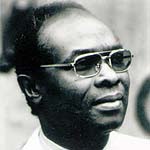 For over 20 years Lamin Sanneh has been an outspoken voice about how Christianity is growing throughout his native continent of Africa. Although he was born a Muslim and received his Ph.D. in Islamic History, he is a convert to Christianity and is a professor of World Christianity at Yale Divinity School. I recently read his 2003 book Whose Religion is Christianity? (William B. Erdmans Publishing). In it Sanneh offers an invaluable perspective on how Christianity is growing and becoming a part of the cultures of many non-western people groups. Sanneh essentially argues that the renewal and resurgence we are now experiencing in non-western settings is a result of translating the Bible into the language of these groups, breaking the hold of the west on the culture of the religion.
For over 20 years Lamin Sanneh has been an outspoken voice about how Christianity is growing throughout his native continent of Africa. Although he was born a Muslim and received his Ph.D. in Islamic History, he is a convert to Christianity and is a professor of World Christianity at Yale Divinity School. I recently read his 2003 book Whose Religion is Christianity? (William B. Erdmans Publishing). In it Sanneh offers an invaluable perspective on how Christianity is growing and becoming a part of the cultures of many non-western people groups. Sanneh essentially argues that the renewal and resurgence we are now experiencing in non-western settings is a result of translating the Bible into the language of these groups, breaking the hold of the west on the culture of the religion.
The book is broken up into six parts, in three sections. The first section lays the ground work. Unlike most of the book, it is more of an essay. The majority of the book is written as an interview where Sanneh writes answers to questions pertinent to the topic. In the first part he explains much of why he is writings, and how he came to make the book.
The second part begins the second section and functions as a bridge between the essay format and the question format that is seen in the third part. It deals with the “facts” that have helped shaped the questions that will follow in the remaining four sections. The third part (Chapter 1 part 2) helps distinguish different terms used to describe Christianity in the world and the connotations that are associated with them. In this section Sanneh addresses some vital questions that Westerners like myself need to be asking, and confront the prejudices and preconceived notions that get in the way. Part four (Ch.2 p.3) is shorter and distills the conversation before. In this section there is particular emphasis on the significance on indigenous cultures and an understanding of human worth as playing an important role in steering the Christian faith in the right direction.
The fifth part begins the third section (chapter 2). Like the first two sections it is written in an essay form. This section deals with how translations have been used from the earliest writings of Christianity until now. Sanneh underscores how Jesus, and early Christians sought to make the message clear and accessible to everyone. The final part of the book, again picks up the interview approach. In this section Sanneh responds to questions that are critical of his emphasis on Bible translation. Although translating the Bible into other languages can bring some sticky baggage, Sanneh finally concludes that it is most importantly a tool that works freedom from the west rather then creating a bondage to the west.
While reading this book my wife and I visited a group of diverse Catholic churches around the neighborhood we live in. Although they all followed the same liturgy it was amazing to see how the culture of the church and the expressions of faith changed as we moved between Spanish, Polish, Indonesian, and suburban American congregations.
I know I personally have often found myself caught up in the discussions of the plurality of different traditions, but haven’t spent as much time exploring the plurality within the individual traditions. This book reminds me that cultures are just as important as denominations when attempting to understand Christianity as a whole.
Many of us in the west have very little awareness to the global nature of Christianity today, let alone the factors that have allowed the faith to spread and evolve. I appreciate both the candor, and authenticity in which Sanneh addresses the questions that arise in evaluating Global Christianity. I hope this book is a taste of more to come as we deal with the systemic shifts happening within our faith.
 For over 20 years Lamin Sanneh has been an outspoken voice about how Christianity is growing throughout his native continent of Africa. Although he was born a Muslim and received his Ph.D. in Islamic History, he is a convert to Christianity and is a professor of World Christianity at Yale Divinity School. I recently read his 2003 book Whose Religion is Christianity? (William B. Erdmans Publishing). In it Sanneh offers an invaluable perspective on how Christianity is growing and becoming a part of the cultures of many non-western people groups. Sanneh essentially argues that the renewal and resurgence we are now experiencing in non-western settings is a result of translating the Bible into the language of these groups, breaking the hold of the west on the culture of the religion.
For over 20 years Lamin Sanneh has been an outspoken voice about how Christianity is growing throughout his native continent of Africa. Although he was born a Muslim and received his Ph.D. in Islamic History, he is a convert to Christianity and is a professor of World Christianity at Yale Divinity School. I recently read his 2003 book Whose Religion is Christianity? (William B. Erdmans Publishing). In it Sanneh offers an invaluable perspective on how Christianity is growing and becoming a part of the cultures of many non-western people groups. Sanneh essentially argues that the renewal and resurgence we are now experiencing in non-western settings is a result of translating the Bible into the language of these groups, breaking the hold of the west on the culture of the religion. 











